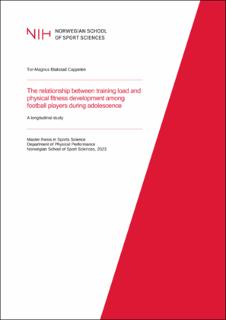| dc.description.abstract | Objectives: Given the importance of physical fitness for football players, it is of interest to further increase this aspect. Additionally, the level of physical fitness increases during adolescence. This study intends to get a better understanding of the relationship between training load measures and development in physical fitness during adolescence.
Method: Boys (14.4 ± 1.6 years, n=16) and girls (14.4 ±0.9 years, n=12) completed pre- and post-testing separated by one year. In-between testing, training load measures were collected for three two-weeks periods. Physical fitness was assessed by performing; 10-m and 30-m sprint, change of direction, countermovement jump, Keiser leg press, and YoYo intermittent recovery test 1. Training load measures were collected using global navigation satellite system units, additionally to self-reported session rate of perceived exertion. Correlation analyses were performed between average training load measures per period and percentage change in physical fitness characteristics.
Results: Boys performed better compared to girls in six physical fitness tests during pre-testing, and eight tests during post-testing. Girls performed better in four tests, whereas boys performed better in all nine tests during post-testing compared to pre-testing. Boys had greater percentage change in total force (31.4% vs. 14.0%) and total power (36.6% vs. 13.5%) in leg press compared to girls. Many training load measures were similar between sexes, but boys covered more distance sprinting (947 ± 620m vs. 468 ± 266m), had more efforts of sprinting (68 ± 42 vs. 36 ± 9) and had more high-intensity efforts (HIE) (543 ± 252 vs. 270 ±113). A total of twenty-four correlations between training load measures and change in physical fitness tests were significant. No correlations were significantly for both sexes. The strongest correlation for boys was between change in relative force and efforts of high relative sprinting (r=0.66), whereas the strongest correlation for girls was between change in relative force and efforts of sprinting (r=0.79).
Conclusion: Boys had a higher level of physical fitness and were also the ones to develop their level of physical fitness the most throughout one year. Boys had higher training load measures of sprinting and HIE. Several training load measures correlated with change in physical fitness, indicating a relationship between these measures. Here, higher training load measures were associated with a greater change in physical fitness. | en_US |
